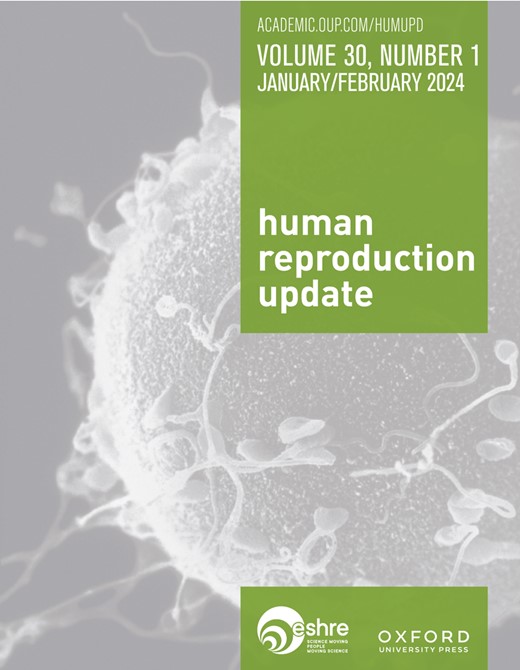HLA b类受体在胚胎着床和妊娠早期的相互作用。
IF 14.8
1区 医学
Q1 OBSTETRICS & GYNECOLOGY
引用次数: 5
摘要
背景尽管免疫系统在胚胎植入和怀孕过程中发挥着重要作用,但其分子细节长期以来一直存在争议。人类白细胞抗原(HLA)系统的作用一直存在争议。在胎儿-母体界面上的HLA Ia类分子HLA-C和HLA Ib类分子HLA E、HLA F和HLA G的独特HLA表达谱现已被识别。然而,HLA Ib类分子也可能在胚胎植入和妊娠成功中发挥作用。目的和原理本综述的目的是评估非多态性HLA Ib类分子在植入时的作用的文献和最新发现,重点是HLA-F和HLA-G分子,包括通过特异性受体免疫球蛋白样转录物2(ILT2)与子宫免疫细胞的相互作用,ILT4和一些杀伤细胞免疫球蛋白样受体(KIRs),以及影响生育能力和怀孕时间的HLA-F和HLA-G基因变异的重要性。研究方法根据基础和临床研究的最新进展,我们对科学文献进行了叙述性综述,以及时更新HLA Ib类在胚胎植入中的作用,生育和不孕。使用相关关键词在PubMed/Medline上搜索相关研究。结果HLA-F和HLA-G都与子宫免疫细胞上的抑制性或活化性ILT2或ILT4受体和KIRs相互作用,尤其是在分泌中期子宫内膜和妊娠早期高度丰富的子宫自然杀伤细胞。HLA-G与ILT2的结合刺激蜕膜NK细胞分泌生长促进因子。然而,HLA-F受体相互作用的功能方面仍有待阐明。最近的研究表明,HLA-F和HLA-G在分泌中期子宫内膜中表达,HLA-G在胚泡中表达。HLA-F在月经周期中波动,在植入窗口期处于高水平。HLA-F蛋白表达水平与分泌中期子宫内膜中CD56阳性NK细胞的数量相关。HLA-F和HLA-G基因多态性,包括黄体酮反应元件中的单核苷酸多态性(SNP),与妊娠时间有关。根据SNP基因型的不同,黄体酮的作用不同,导致HLA-F表达的差异,从而导致与子宫NK细胞上受体的相互作用。研究表明,胚胎来源的滋养层细胞、子宫内膜和蜕膜细胞表达HLA-G和HLA-F,以及HLA-G和HLA-F与子宫免疫细胞上特定受体的相互作用,通过分泌生长因子、细胞因子和血管生成因子刺激和促进胚胎植入和胎盘形成。更广泛的植入对控制HLA-F和HLA-G在围产期和妊娠早期表达的分子机制的详细了解可能会提高ART的成功率,并有望进一步深入了解某些妊娠并发症的病理生理学方面。本文章由计算机程序翻译,如有差异,请以英文原文为准。
HLA Class Ib-receptor interactions during embryo implantation and early pregnancy.
BACKGROUND
Although the immune system intuitively must have an important role in embryo implantation and in the achievement of a pregnancy, the molecular details have for long been controversial. The role of the human leukocyte antigen (HLA) system has been debated. The unique HLA expression profile of the HLA Class Ia molecule HLA-C and the HLA Class Ib molecules HLA-E, HLA-F and HLA-G at the feto-maternal interface is now recognized. However, HLA Class Ib molecules may also have a role in embryo implantation and pregnancy success.
OBJECTIVE AND RATIONALE
The aim of this review was to evaluate the literature and recent discoveries on the role of the non-polymorphic HLA Class Ib molecules with a focus on HLA-F and HLA-G molecules at the time of implantation, including the interaction with uterine immune cells through the specific receptors immunoglobulin-like transcript 2 (ILT2), ILT4 and a number of killer cell immunoglobulin-like receptors (KIRs), and the importance of HLA-F and HLA-G genetic variation that influences fertility and time-to-pregnancy.
SEARCH METHODS
Drawing on recent advances in basic and clinical studies, we performed a narrative review of the scientific literature to provide a timely update on the role of HLA Class Ib in embryo implantation, fertility and infertility. Pertinent studies were searched in PubMed/Medline using relevant key words.
OUTCOMES
Both HLA-F and HLA-G interact with inhibitory or activating ILT2 or ILT4 receptors and KIRs on uterine immune cells, especially uterine natural killer (NK) cells that are highly abundant in the mid-secretory endometrium and in early pregnancy. The binding of HLA-G to ILT2 stimulates the secretion of growth-promoting factors from decidual NK cells. However, functional aspects of a HLA-F-receptor interaction remain to be clarified. Recent studies indicate that HLA-F and HLA-G are expressed in mid-secretory endometrium and HLA-G is expressed in the blastocyst. HLA-F fluctuates during the menstrual cycle with high levels during the implantation window. The level of HLA-F protein expression correlates with the number of CD56-positive NK cells in the mid-secretory endometrium. HLA-F and HLA-G gene polymorphisms, including a single nucleotide polymorphism (SNP) in a progesterone-responsive element, are associated with time-to-pregnancy. Depending on the SNP genotype, the effect of progesterone varies resulting in differences in HLA-F expression and thereby the interaction with receptors on the uterine NK cells. Studies suggest that the expression of HLA-G and HLA-F, both by the embryonic-derived trophoblast cells and by cells in the endometrium and decidua, and the interaction between HLA-G and HLA-F with specific receptors on uterine immune cells, stimulate and facilitate embryo implantation and placentation by secretion of growth factors, cytokines and angiogenic factors.
WIDER IMPLICATIONS
A detailed understanding of the molecular mechanisms controlling the expression of HLA-F and HLA-G periconceptionally and in early pregnancy may improve the success of ART and holds promise for further insight into pathophysiological aspects of certain pregnancy complications.
求助全文
通过发布文献求助,成功后即可免费获取论文全文。
去求助
来源期刊

Human Reproduction Update
医学-妇产科学
CiteScore
28.80
自引率
1.50%
发文量
38
期刊介绍:
Human Reproduction Update is the leading journal in its field, boasting a Journal Impact FactorTM of 13.3 and ranked first in Obstetrics & Gynecology and Reproductive Biology (Source: Journal Citation ReportsTM from Clarivate, 2023). It specializes in publishing comprehensive and systematic review articles covering various aspects of human reproductive physiology and medicine.
The journal prioritizes basic, transitional, and clinical topics related to reproduction, encompassing areas such as andrology, embryology, infertility, gynaecology, pregnancy, reproductive endocrinology, reproductive epidemiology, reproductive genetics, reproductive immunology, and reproductive oncology. Human Reproduction Update is published on behalf of the European Society of Human Reproduction and Embryology (ESHRE), maintaining the highest scientific and editorial standards.
 求助内容:
求助内容: 应助结果提醒方式:
应助结果提醒方式:


